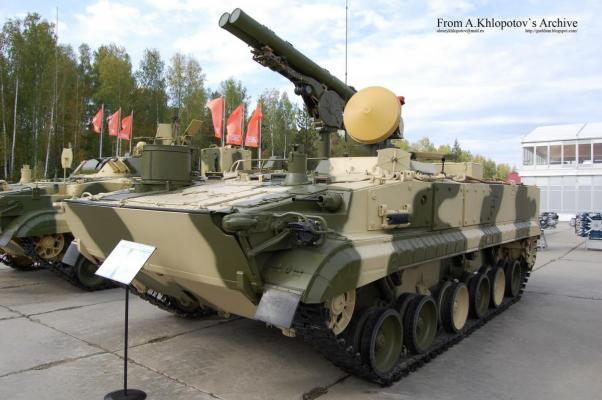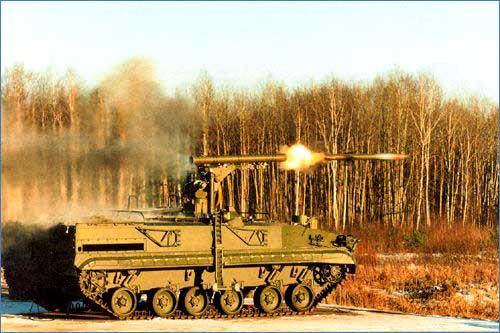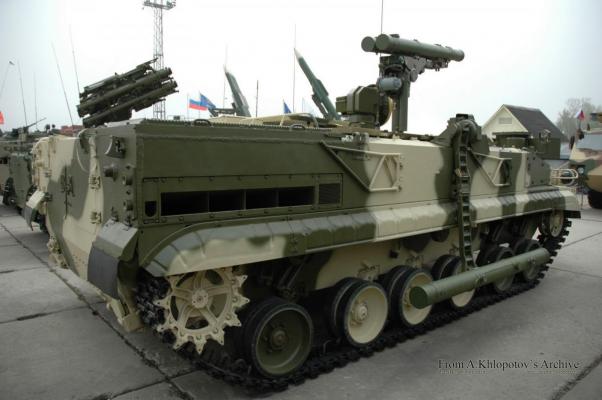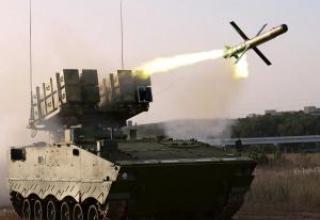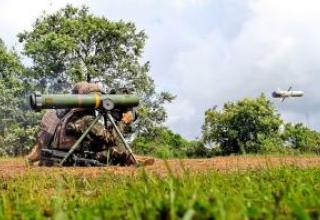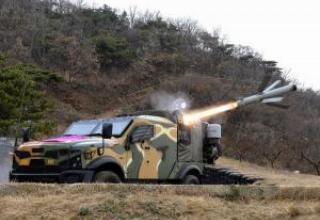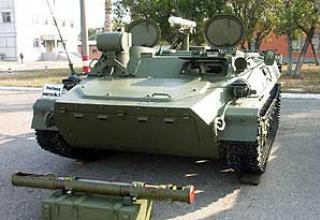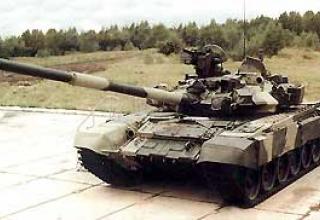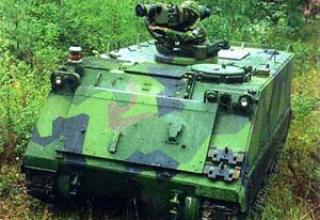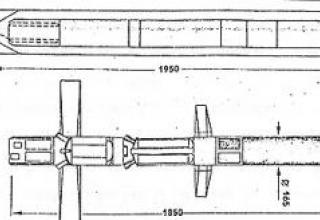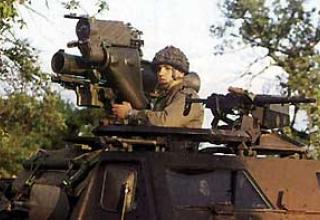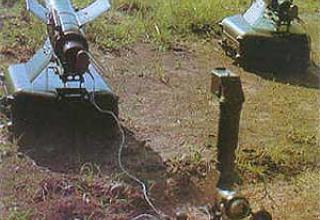The "Chrysanthemum" complex is designed to defeat modern as well as advanced tanks of any type, including those equipped with dynamic protection. In addition to armoured vehicles, the complex can engage low-tonnage surface targets, hovercrafts, low-sonic air targets, reinforced concrete structures, armoured shelters and bunkers.
Distinctive properties of "Chrysanthemum" PTWC are:
- high immunity against radio and IR interference,
- to point two missiles at different targets simultaneously,
- short flight time due to the supersonic speed of the rocket,
- Possibility of round-the-clock application in simple and difficult weather conditions, as well as in the presence of dust and smoke interference.
Chrysanthemum" PTR was developed in KBM (Kolomna). "Chrysanthemum-S is the most powerful land-based antitank complex currently in existence. Long range of effective fire in any combat and weather conditions, protection, high firing speed make it indispensable during both offensive and defensive operations of the ground forces.
Composition:
The main feature of this PTUR is its ability to hit the enemy's armor on the battlefield without the need for optical and thermal sighting. "Chrysanthemum-S is equipped with its own radar station operating in the range of radio waves - 100-150 GHz (2-3 mm waves). The radar provides target detection and tracking with simultaneous guidance of the missile during pointing. The tracking and control process is carried out in automatic mode, without operator's participation. Due to the presence of an additional laser guidance system PTUR operator can fire in volley, simultaneously on two different objects, using different aiming channels.
The 9M123 missile is built according to the normal aerodynamic scheme. Aerodynamic rudders, placed perpendicular to the plane of the engine nozzle axes, and their drive are in the tail of the missile. Rocket wings are structurally similar to those used on the missile complex "Assault" and placed in front of the nozzle block.
The missile can be equipped with various types of combat units. Rocket 9M123-2 (see photo 1, photo 2) is equipped with a powerful tandem warhead with a diameter of 152 mm and breaks through the dynamic protection of armor thickness of 1.100 -1.200 mm. There is an option to equip the missile with a high-explosive (thermobaric) warhead, in this case it is designated by the index 9M123F-2.
Based on the BMP-3 chassis, the 9P157-2 combat vehicle with a crew of two carries a set of 15 9M123-2 or 9M123F-2 missiles in transport and launch containers. It has high maneuverability and high cross-country ability, is equipped with collective and individual protection means against weapons of mass destruction, and can overcome water obstacles afloat using 2 water-jet propellers with the speed of 10 km/h without prior preparation.
In addition to the retractable launcher, the radar antenna (see photo) is also placed closer to the port side of the vehicle (see photo). The selection of the missiles required for a combat mission from the launcher (see photo) is done automatically at the operator's command. All processes related to the transfer of the launcher from the camping position to the combat position and back, charging and recharging are fully automated and are carried out by the operator with a special remote control at the workplace.
The three Chrysanthemum-S combat vehicles are capable of successfully repelling an attack by a company of fourteen tanks. It is possible to operate several BMs on one or more targets close by.
Chrysanthemum-S units have their own composition:
- Commander's Combat Vehicle (CV) 9P157-4, which provides early target detection and recognition, determination of target coordinates, and target distribution among linear machines with target coordinates.
- maintenance equipment:
- training means - simulator 9F852.
The 9F852 simulator is designed to train combat vehicle operators, maintain and improve their professional skills. The composition of the simulator: simulators operator panel 9P157, blocks of product 1L32, control panel 1B150-1 product 1K118, a combined optical control unit product 1K118 from BM 9P157, switching unit. The microcontroller of a side of switching carries out data exchange between PC and simulators of panel equipment. "Launches" of rockets are accompanied by visual and sound effects accompanying the firing of a war machine, the sound of the rocket descent, smoke interference from the rocket engine, as well as the sound background of the "battle". On the screen of the visual environment imitator video monitor is formed three-dimensional color image of targets (such as - tank, BMP, helicopter), sighting mark, rangefinder and anglefinder scale.
Characteristics of tasks for training in optical beam and combined modes of operation
- group targets are two or three in a group;
- ground target speed between 5 and 60 km/h;
- types of target movement - flank, frontal, kosoe, "snake" on the medium crossed terrain.
Characteristics of tasks for radar training:
- group targets (three to five per group);
- speed of ground targets - 10 to 60 km/hour, air targets - up to 340 km/hour;
- types of movement of ground targets: flank, frontal, kite, "kite" on a medium crossed terrain, a column of moving point targets at a given frequency.
Complex "Chrysanthemum-C" is multifunctional and can be placed on carriers with a carrying capacity of at least 3 tons. It is also possible to place the complex as an anti-ship weapon on boats.
Characteristics:
| Range of fire, m | 400-6000 |
| Flight Speed, m/sec | 400 |
| Missile launch weight 9M123 , kg | 46 |
| Weight of the rocket in the TPC, kg | 54 |
| The dimensions of missile 9M123, mm: - length - case diameter - wingspan |
2057 150 310 |
Testing:
One of the first carriers of the complex is a multipurpose nuclear submarine of the project 885 "Ash", which belongs to the fourth generation of submarines. The keelmark in the series, called "Severodvinsk", took place on December 21, 1993. The boat carries 24 missiles in inclined launch shafts. The natural model of the new anti-ship missile in an export version (a variant for underwater, surface and shore-based), was first publicly demonstrated at the exhibition MAKS-97. It was also exhibited at MAKS-99.
The advertising passport for the small rocket ship of project 21632 "Tornado" (approved on 26.04.2008) indicates the possibility of placing the Yakhont complex as one of the weapon variants.
According to military analysts' forecasts, the Yakhont complex will have no analogues in the world for another 10 years. This can be proved by the interest expressed by foreign buyers. A number of countries of the Asia-Pacific region, the Middle East, which in the past bought Russian ships and boats with cruise missiles, have already become interested in the novelty of the domestic military industrial complex. PCR Yakhont also has good prospects in terms of upgrading foreign-built ships, where it can replace the Harpoon, Exocet, and Otomat anti-ship complexes.
Sources:
- Р.Д.Ангельский "Отечественные противотанковые комплексы" -М: ООО "Издательство Астрель", 2002,-192с.
- КБМ
- Машина 9П157-4 управления батареей ракетного комплекса 9К123 «Хризантема-С» (фотодетализация)
- http://technic-memorial.narod.ru/Hrizantema-S/Hrizantema-S.htm
